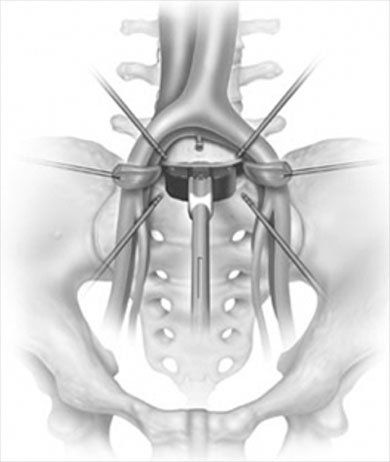I Have a Lot of Patients With L5-S1 Degenerative Disc Disease. What Surgical Options Do I Have for Accessing the Anterior L5-S1 Interspace?
L5-S1 degenerative disc disease is a common pathologic entity, and many surgical interventions have been entertained for the treatment of this condition. It has been my experience that indications are the most important factor in determining surgical success in the treatment of this condition.
Access to the L5-S1 interspace can be challenging because of the presence of the pelvis and abdominal vasculature. The iliac crests almost always interfere with a direct lateral approach. Although it is possible to perform a transforaminal lumbar interbody fusion (TLIF) procedure at this interspace, it is my personal experience that the exposure is typically limited and more difficult to accomplish. A posterior lumbar interbody fusion (PLIF) may be accomplished at the L5-S1 interval as a way to posteriorally access the intervertebral disc. Challenges with the PLIF at this level include excessive retraction of the neural elements. A new procedure, the AxiaLIF, makes use of a reverse Herbert screw technique to create an L5-S1 fusion via a percutaneous approach. Disc removal, a key component of any interbody fusion procedure, is incomplete in all procedures except anterior lumbar interbody fusion (ALIF). Successful fusion with any of these techniques demands enough disc removal to allow for sufficient bony growth from endplate to endplate.
ALIF is my preferred technique for accessing the L5-S1 intervertebral level. An anterior approach may be accomplished in several different ways and is often specific to the institution and the surgeon. Some institutions rely heavily on approach surgeons, general or vascular surgeons, who can assist with access to this disc space. Some surgeons prefer to accomplish this approach on their own, and as such the approach is made much easier with good surgical assistance and the absence of prior abdominal or pelvic surgery and/or radiation. Finally, an ALIF may also be performed via a laparoscopic approach. This has been well described, although the relative advantages of this approach over the standard open approach have been debated, and the increase in results are marginal at best.1
It is important to understand the preoperative vascular anatomy of those patients you choose to access via an anterior route.2 The iliac artery and vein bifurcate in this region. The bifurcation typically occurs at or just above the L5-S1 interspace (Figures 9-1 and 9-2). In many cases this presents an ideal access for a direct anterior approach after a retroperitoneal or transperitoneal dissection has been accomplished. The case is certainly made more challenging if the bifurcation occurs below the L5-S1 interval because appropriate mobilization of the vasculature may be difficult.

Figure 9-1. A typical incision made for a retroperitoneal approach to the L5-S1 disc space.

Figure 9-2. A schematic demostrating retraction of the external iliac vein with insertion of an ALIF cage.
References
1. Rodriguez HE, Connolly MM, Dracopoulos H, et al. Anterior access to the lumbar spine: laparoscopic versus open. Am Surg. 2002;68:978-982.
2. Vraney RT, Phillips FM, Wetzel FT, et al. Peridiscal vascular anatomy of the lower lumbar spine: an endoscopic perspective. Spine. 1999;24:2183-2187.
